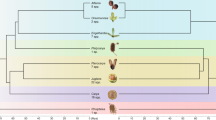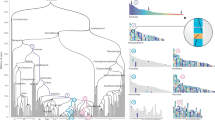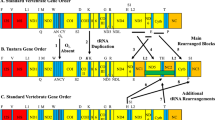Abstract
MAMMALIAN mitochondria! DNA sequences evolve more rapidly than nuclear sequences1. Although the rapid rate of evolution is an advantage for the study of closely related species and populations, it presents a problem in situations where related species, used as outgroups in phylogenetic analyses, have accumulated so much change that multiple substitutions obliterate the phylogenetic information2. However, mitochondrial DNA sequences are frequently inserted into the nuclear genome3, where they presumably evolve as nuclear pseudogene sequences and therefore more slowly than their mitochondria! counterparts. Such sequences thus represent molecular 'fossils' that could shed light on the evolution of the mitochondrial genome and could be used as outgroups in situations where no appropriate outgroup species exist. Here we show that human chromosome 11 carries a recent integration of the mitochondrial control region that can be used to gain further insight into the origin of the human mitochondrial gene pool.
This is a preview of subscription content, access via your institution
Access options
Subscribe to this journal
Receive 51 print issues and online access
$199.00 per year
only $3.90 per issue
Buy this article
- Purchase on Springer Link
- Instant access to full article PDF
Prices may be subject to local taxes which are calculated during checkout
Similar content being viewed by others
References
Brown, W. M., Prager, E. M., Wang, A. & Wilson, A. C. J. molec. Evol. 18, 225–239 (1982).
Maddison, D. R., Ruvolo, M. & Swofford, D. L. Syst. Biol. 41, 111–124 (1992).
Zullo, S., Sieu, L. L., Slightom, J. L., Hadler, H. I. & Eisenstadt, J. M. J. molec. Biol. 221, 1223–1235 (1991).
Cann, R. L., Stoneking, M. & Wilson, A. C. Nature 325, 31–36 (1987).
Vigilant, L., Stoneking, M., Harpending, H., Hawkes, K. & Wilson, A. C. Science 253, 1503–1507 (1991).
Templeton, A. R. Science 255, 737 (1992).
Hedges, S. B., Kumar, S., Tamura, K. & Stoneking, M. Science 255, 737–739 (1992).
Maddison, D. R. Syst. Zool. 40, 355–363 (1991).
Ruvolo, M., Disotell, T. R., Allard, M. W., Brown, W. M. & Honeycutt, R. L. Proc. natn. Acad. Sci. U.S.A 88, 1570–1574 (1991).
Gill, P., Jeffreys, A. J. & Werrett, D. J. Nature 318, 577–579 (1985).
Anderson, S. et al. Nature 290, 457–465 (1981).
Tapper, D. P. & Clayton, D. A. J. biol. Chem. 256, 5106–5115 (1981).
Doda, J. N., Wright, C. T. & Clayton, D. A. Proc. natn. Acad. Sci. U.S.A. 78, 6116–6120 (1981).
Pult, I. et al. Biol. Chem. Hoppe-Seyler 375, 837–840 (1994).
Nei, M. Molecular Evolutionary Genetics (Columbia Univ. Press, New York, 1987).
Ward, R. H., Frazier, B. L., Dew-Jager, K. & Pääbo, S. Proc. natn. Acad. Sci. U.S.A. 88, 8720–8724 (1991).
Lundstrom, R., Tavaré, S. & Ward, R. H. Proc. natn. Acad. Sci. U.S.A. 89, 5961–5965 (1992).
Morin, P. A., Moore, J. J., Chakraborty, R., Jin, L., Goodall, J. & Woodruff, D. S. Science 285, 1193–1201 (1994).
Sambrook, J., Fritch, E. F. & Maniatis, T. Molecular Cloning: A Laboratory Manual (Cold Spring Harbor Laboratory Press, New York, 1989).
Pena, S. D. J. et al. Proc. natn. Acad. Sci. U.S.A. 91, 1946–1949 (1994).
Felsenstein, J. Phylip version 3.5p (Univ. Washington, Seattle, 1994).
Author information
Authors and Affiliations
Rights and permissions
About this article
Cite this article
Zischler, H., Geisert, H., von Haeseler, A. et al. A nuclear 'fossil' of the mitochondrial D-loop and the origin of modern humans. Nature 378, 489–492 (1995). https://doi.org/10.1038/378489a0
Received:
Accepted:
Issue Date:
DOI: https://doi.org/10.1038/378489a0
This article is cited by
-
Mitochondrial DNA variation of the caracal (Caracal caracal) in Iran and range-wide phylogeographic comparisons
Mammalian Biology (2023)
-
Fidelity varies in the symbiosis between a gutless marine worm and its microbial consortium
Microbiome (2022)
-
Profile hidden Markov model sequence analysis can help remove putative pseudogenes from DNA barcoding and metabarcoding datasets
BMC Bioinformatics (2021)
-
First Report of a Mitochondrial Pseudogene in Agnathan Vertebrates (Cyclostomata: Petromyzontidae)
Journal of Molecular Evolution (2018)
-
Factors Affecting the Relative Abundance of Nuclear Copies of Mitochondrial DNA (Numts) in Hominoids
Journal of Molecular Evolution (2012)
Comments
By submitting a comment you agree to abide by our Terms and Community Guidelines. If you find something abusive or that does not comply with our terms or guidelines please flag it as inappropriate.



